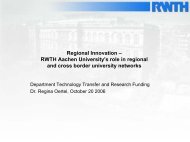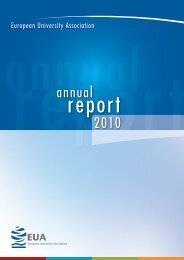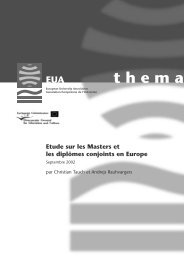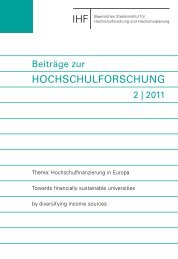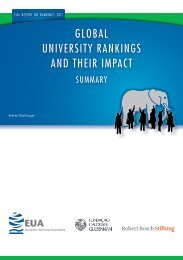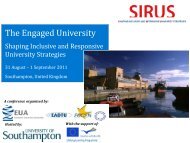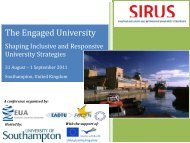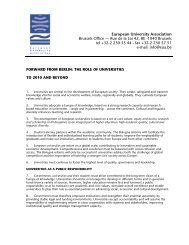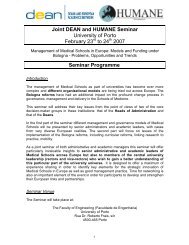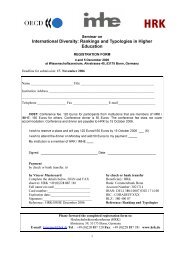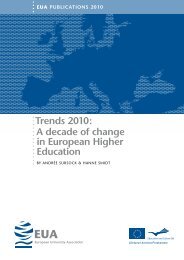Examining Quality Culture Part II: - European University Association
Examining Quality Culture Part II: - European University Association
Examining Quality Culture Part II: - European University Association
You also want an ePaper? Increase the reach of your titles
YUMPU automatically turns print PDFs into web optimized ePapers that Google loves.
ExAmININg QUALITy CULTUrE PArT <strong>II</strong>: PrOCESSES ANd TOOLS – PArTICIPATION, OwNErShIP ANd BUrEAUCrACy<br />
The changing status of deans, while not yet typical in continental Europe, points nevertheless to<br />
an emerging trend: that of integrating deans in the top management teams rather than confining them<br />
to merely representing their faculties (Sursock 2010). If this trend grows, it will strengthen institutional<br />
strategies and institutional accountability and, by implication, will lead to an effective use of quality assurance<br />
results. Indeed, an effective quality culture and quality assurance mechanisms can only be developed if (i)<br />
responsibilities are shared and accountability lines are clear and (ii) if the leadership – at all levels of the<br />
university – is pulling in the same direction and able to persuade the staff that they are important players<br />
(and beneficiaries) in achieving the strategic orientation of the institution.<br />
5.2.2 Students<br />
The EQC survey showed that students’ involvement in internal quality assurance varies (Loukkola and<br />
Zhang 2011: 24). It is difficult, however, to see exactly what this finding means based on the survey results<br />
only. The interviews provide further details and clarification.<br />
In eight of the ten universities, students were involved in internal quality assurance processes and<br />
discussions either because there is a culture of student involvement at all levels of the university and a clear<br />
recognition of their added-value or because it is a national requirement. One student leader explained<br />
student involvement in her university as follows:<br />
Students are involved at all levels of the university, from planning courses to university strategy<br />
and budgets. They do not receive formal training but there is an introductory meeting. I was very<br />
surprised to see that the university was very open to student input in decision-making. Students are<br />
consulted in a meaningful way but they are more useful on some topics (courses) than on others<br />
(university budget). At the faculty or department level, students are involved in course planning<br />
and course development. They sit on the department councils which give input to the faculty.<br />
Teachers get together in programme groups (no student) and in programme boards that review<br />
programme proposals (with students).<br />
This student, however, added that “students are not always treated as adults and they don’t<br />
always act as adults”. This was seen as a causal relationship that could be changed: giving students more<br />
responsibilities would increase the chance of changing their behaviour.<br />
Other interviewees reported problems with student participation:<br />
• In one institution, students were seen as making sometimes unreasonable demands. This was<br />
confirmed to some extent (although not acknowledged) by the head of the student union who<br />
stated: “Students are invited to many meetings to discuss issues and there are lots of opportunities<br />
to be active but sometimes the university does not listen to what we say”.<br />
• Some interviewees remarked that the student population is changing and that students have become<br />
more demanding. Sometimes, but not always, this is linked to student fees. One interviewee noted<br />
that students are more aware of their rights: “Academics have become compliant with whatever<br />
they are asked to do because they know that the students know about the ombudsman’s office and<br />
the process of lodging a complaint”.<br />
• In another institution, students were involved in the process of designing the internal quality<br />
assurance processes, but they dropped out of the committee when they realised that it was focused<br />
on teachers’ development.<br />
• Finally, one institution recognised that “the involvement of students in quality assurance processes<br />
is one of our weaknesses. Most do not know the system and are concentrating on their studies.<br />
We should improve communication with the students”. One person suggested that this might be<br />
due to the institutional merger that increased staff workloads; the two student unions, too, had to<br />
29



